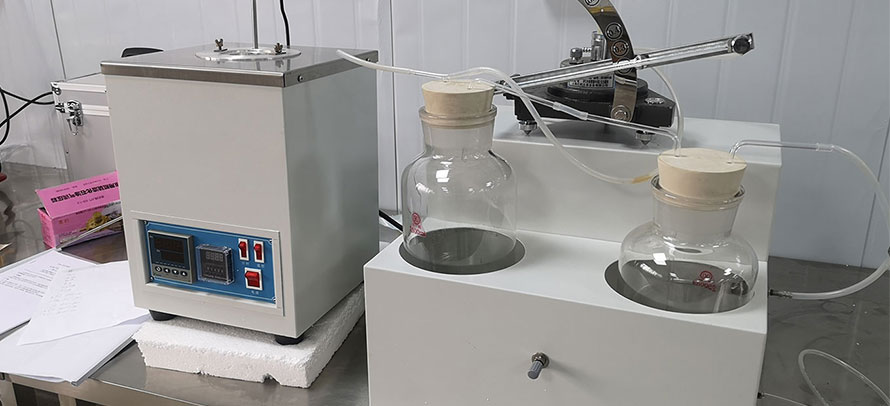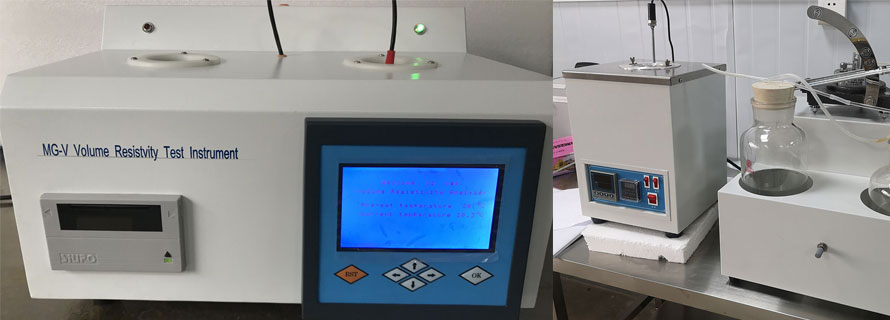ASTM D3227 Sulfur in Gasoline, Kerosine, Aviation Turbine, and Distillate Fuels
ASTM D3227 Standard Test Method for (Thiol Mercaptan) Sulfur in Gasoline, Kerosine, Aviation Turbine, and Distillate Fuels (Potentiometric Method)
5. Apparatus
5.1 As described in 5.2-5.5; alternatively, any automatic titration system may be used that, using the same electrode pair described in 5.3, is capable of performing the titration as described in Section 9 and selecting the endpoint specified in 11.1 with a precision that meets or is better than that given in Section 13.
5.2 Meter - An electronic voltmeter, operating on an input of less than 9 x 10(-12) A and having a sensitivity of ±2 mV over a range of at least ±1 V. The meter shall be electrostatically shielded, and the shield shall be connected to the ground.
5.3 Cell System, consisting of a reference and indicating electrode. The reference electrode should be a sturdy, pencil-type glass electrode, having a shielded lead connected to ground. The indicating electrode shall be made from a silver wire, 2 mm (0.08 in.) in diameter or larger, mounted in an insulated support. Silver billet electrodes can also be used.
5.4 Buret, 10-mL capacity, graduated in 0.05-mL intervals, with a tip that extends approximately 120 mm (5 in.) below the stopcock.
5.5 Titration Stand, preferably built as an integral part of the meter housing and provided with supports for the electrodes and electrical stirrer, all connected to ground. No permanent change in meter reading should be noticeable upon connecting or disconnecting the stirring motor.
6. Reagents and Materials
6.1 Purity of Reagents - Reagent grade chemicals shall be used in all tests. Unless otherwise indicated, it is intended that all reagents shall conform to the specifications of the Committee on Analytical Reagents of the American Chemical Society, where such specifications are available. Other grades may be used, provided it is first ascertained that the reagent is of sufficiently high purity to permit its use without lessening the accuracy of the determination.
6.1.1 Commercially available solutions may be used in place of prepared laboratory solutions, when they are certified to meet the required concentrations.
6.1.2 Alternate volumes of solutions and solvents may be prepared, when an equivalent concentration is maintained.
6.2 Water - Reagent grade, Type I, Specification D1193.
6.3 Cadmium Sulfate, Acid Solution (150 g/L) - Dissolve 150 g of cadmium sulfate (3CdSO4•8H2O) in water. (Warning - Poison. May be fatal if swallowed or inhaled. A known carcinogen (animal positive).) Add 10 mL of dilute H2SO4 (Warning - Poison. Causes severe burns. Harmful or fatal if swallowed or inhaled) and dilute to 1 L with water.
6.4 Potassium Iodide, Standard Solution (approximately 0.1 mol/L) - Dissolve 17 g of KI (weigh to 0.01 g) in 100 mL of water in a 1-L volumetric flask and dilute to 1 L. Calculate the exact molarity.
6.5 Propan-2-ol - (Warning - Flammable. Warning - Unless inhibited against it, peroxides can form in propan-2-ol when stored in the same container that is exposed to air. When this happens and the propan-2-ol evaporates to dryness, an explosion can occur. When peroxides are suspected, they may be removed by percolation through an activated alumina column.)
6.6 Silver Nitrate, Standard Alcoholic Solution (0.1 mol/L) - Dissolve 17 g of AgNO3 in 100 mL of water in a 1-L volumetric flask and dilute to 1 L with propan-2-ol (99 %) (see Note 1). Store in a dark bottle and standardize at intervals frequent enough to detect a change of 0.0005 or greater in molarity.
NOTE 1 - It is important to pass the propan-2-ol through a column of activated alumina to remove peroxides that may have formed on storage; failure to remove peroxides will lead to low results. It is not necessary to perform this step if the alcohol is tested and found free of peroxides.
6.6.1 Standardization - Add six drops of concentrated HNO3 (relative density 1.42) (Warning - Poison. Causes severe burns. Harmful or fatal if swallowed or inhaled) to 100 mL of water in an appropriately sized beaker (for example, a 200-, 250-, or 300-mL size beaker is typically large enough). Remove oxides of nitrogen by boiling for 5 min. Cool to ambient temperature. Pipet 5 mL of 0.1 mol/L KI solution into the beaker and titrate with the AgNO3 solution choosing the end point at the inflection of the titration curve.
6.7 Silver Nitrate, Standard Alcoholic Solution (0.010 mol/L) - Prepare daily when the test is being performed by dilution of the 0.1 N standard. Pipet 100 mL of the 0.1 mol/L standard into a 1-L volumetric flask and dilute to volume with propan-2-ol. Calculate the exact molarity.
6.8 Sodium Sulfide Solution (10 g/L) - Dissolve 10 g of Na2S in water and dilute to 1 L with water. Prepare fresh as needed.
6.9 Sulfuric Acid, dilute. Cautiously dilute five volumes of water with one volume of sulfuric acid (relative density 1.84). (Warning - Adding the acid will generate heat: mix well. If water begins to boil, cool before adding more acid.) Note that only limited volumes are required because only 10 mL are needed for each litre of cadmium sulfate solution.
6.10 Titration Solvent - Low molecular weight mercaptans, as usually found in gasoline, are readily lost from the titration solution if an acidic titration solvent is used. For the determination of the higher molecular weight mercaptan as normally encountered in kerosines, aviation turbine fuels, and distillate fuels, the acidic titration solvent is used to achieve more rapid equilibrium between successive additions of the titrant.
6.10.1 Alkaline Titration Solvent - Dissolve 2.7 g of sodium acetate trihydrate (NaC2H3O2•3H2O) or 1.6 g of anhydrous sodium acetate (NaC2H3O2) in 25 mL of water free of dissolved oxygen and pour into 975 mL of propan-2-ol (99 %) (Note 1). When necessary, remove dissolved oxygen by purging the solution with a rapid stream of nitrogen for 10 min each day prior to use; keep protected from the atmosphere. To minimize oxygen from dissolving in the solution during storage, an option exists to nitrogen blanket the solution prior to sealing the solvent container.
6.10.2 Acidic Titration Solvent - Dissolve 2.7 g of NaC2H3O2•3H2O or 1.6 g of NaC2H3O2 in 20 mL of water free of dissolved oxygen and pour into 975 mL of propan-2-ol (99 %) (Note 1) and add 4.6 mL of glacial acetic acid. When necessary, remove dissolved oxygen by purging the solution with a rapid stream of nitrogen for 10 min each day prior to use; keep protected from the atmosphere. To minimize oxygen from dissolving in the solution during storage, an option exists to nitrogen blanket the solution prior to sealing the solvent container.
6.11 Polishing Paper or Cloth, 6 - 20 µm average particle size abrasive.
7. Sampling
7.1 Take the sample in accordance with Practice D4057 or Practice D4177.
7.2 Methanethiol (methyl mercaptan) has a boiling point of 6.2°C and may be expected to be present in light untreated gasolines. Therefore, when the presence of this low boiling thiol (mercaptan) is known or expected, specimen to be tested shall be kept below 4°C to prevent the loss of mercaptan from such samples.

